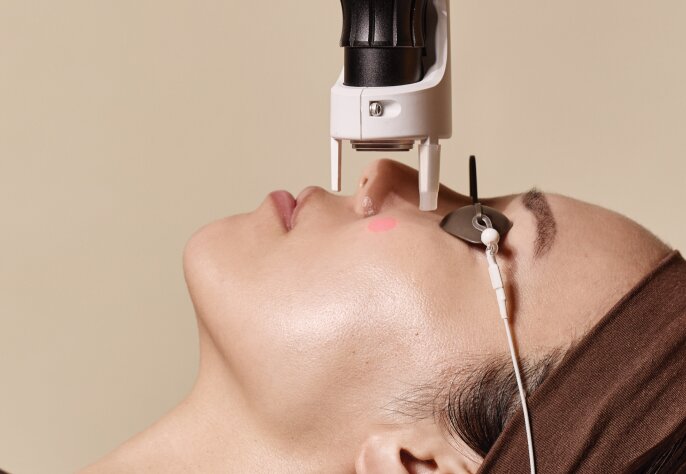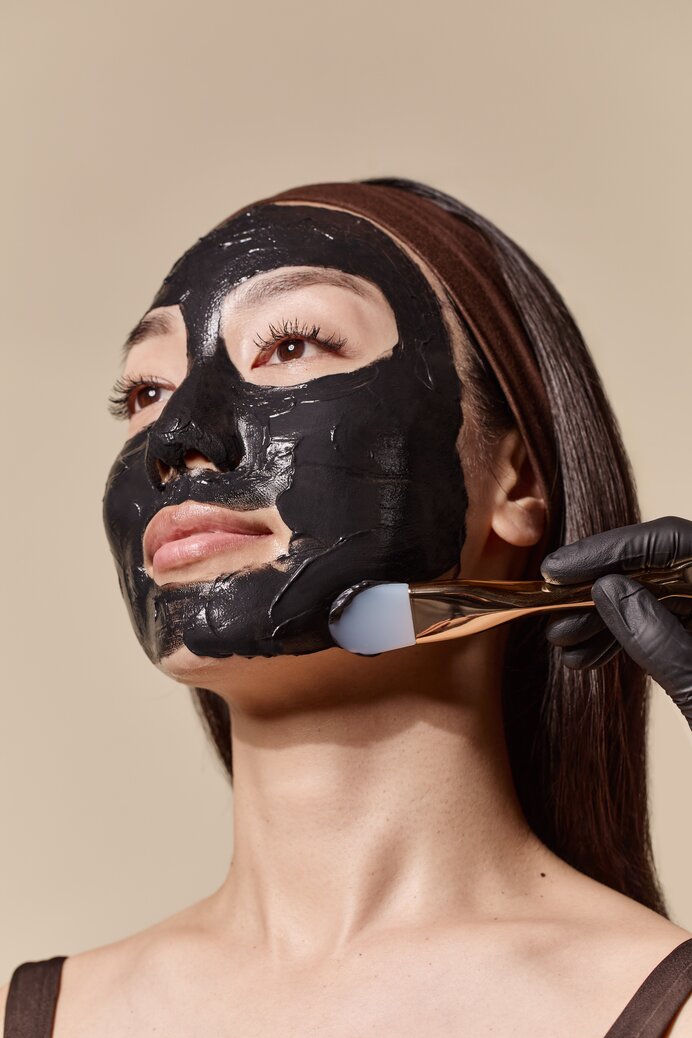
DOCTOR'S NOTE
Acne: What Causes It and How To Treat It
A dermatologist explains the causes of this common skin condition and how to prevent and treat it
Acne is a common and often frustrating skin condition that affects millions of people around the world. Whether you're experiencing it as a teenager during puberty or dealing with adult acne, understanding its causes and triggers is key to managing and treating it effectively.
Here, with the help of our Chief Medical Officer Dr Roberta Del Campo, we discuss the various causes of acne, common myths, how to prevent flare-ups and how best to treat it.
Acne forms when hair follicles become clogged with excess sebum, dead skin cells and bacteria.
What Are the Primary Causes of Acne?
Sebaceous glands are tiny glands found near the surface of your skin. These glands are attached to hair follicles, which are small holes in your skin that an individual hair grows out of.
Sebaceous glands lubricate the hair and the skin to prevent it from drying out. They do this by producing an oily substance called sebum.
In acne, these glands begin to produce too much sebum. This excess sebum then mixes with dead skin cells and forms a plug in the follicle. Normally harmless bacteria that live on the skin can then contaminate and infect the plugged follicles, causing papules, pustules, nodules or cysts.
If the plugged follicle is close to the surface of the skin, it bulges outwards, creating a whitehead. If the opening of that follicle is exposed to the air, it forms a blackhead.
"Acne forms when hair follicles become clogged with excess sebum, dead skin cells and bacteria. It's important to note that while genetics and hormones are key contributors, other factors such as stress, diet, and certain medications can also play a role," says Del Campo, a board-certified dermatologist.
While genetics and hormones are key contributors, other factors such as stress, diet and certain medications can also play a role.
Testosterone
Teenage acne is triggered by increased levels of the hormone testosterone, which occurs during puberty. Sebaceous glands are particularly sensitive to hormones. It's thought that increased levels of testosterone cause the glands to produce much more sebum than the skin needs.
Read more about teen acne here.
Genetics
Acne can run in families. If your parents had acne, it's likely that you'll also develop it.
Acne in women
Women are more likely to have adult acne than men because of natural changes in hormone levels. Fluctuations of estrogen, progesterone and testosterone happen mostly during menstruation cycles, pregnancy and menopause. Polycystic ovary syndrome (PCOS) is another common condition that can cause acne.
Read more about peri/menopausal skin here.
Other triggers
Other possible triggers of an acne flare-up include:
Cosmetic products – Acne cosmetica is acne caused by pore-clogging (comedogenic) cosmetics. Ingredients like lanolin and coconut oil are known to be comedogenic.
Medications – Drugs including corticosteroids, lithium, anticonvulsants, barbiturates, androgenic steroids, DHEA and medications that contain bromides or iodides can cause acne.
Smoking – Smoking can impair blood circulation to the skin, potentially impacting acne healing and contributing to acne.
Stress: Psychological stress can trigger hormonal changes that may lead to increased sebum production and acne breakouts.
Sleep: Inadequate sleep can disrupt hormone balance and impair skin repair, potentially contributing to acne
Diet: Foods with a high glycemic index that cause a rapid spike in blood sugar levels can lead to inflammation and increased oil production in the skin. Some evidence suggests that dairy, especially low-fat skim milk, may be associated with acne.
Acne Myths
Despite being one of the most widespread skin conditions, acne is also one of the most poorly understood. There are many myths and misconceptions about it:
‘Only people with oily skin get acne’
People with dry skin can also get acne. In fact, when your skin is dry, it produces more oil to protect itself from environmental factors. This excess oil can build up in pores, along with dead skin cells and bacteria, and lead to acne.
'Squeezing blackheads and whiteheads is the best way to get rid of acne'
Popping or picking at pimples and active acne can make symptoms worse, leading to further inflammation and may leave you with scarring.
'Sunbathing and sunbeds help improve the symptoms of acne'
There's no conclusive evidence that prolonged exposure to sunlight or using sunbeds or sunlamps can improve acne. Many medicines used to treat acne can make your skin more sensitive to light, so exposure could cause painful damage to your skin, and also increase your risk of skin cancer.
'Acne is infectious'
You cannot pass acne on to other people.
‘Just leave it alone, it’ll go away on its own”
While you shouldn’t pop or pick at a pimple, you should also not neglect it. Chronic acne can be treated by a trained dermatologist or skincare provider who can recommend topical products, medications and professional treatments.
By penetrating the skin and delivering focused light energy, our lasers can reduce the size and activity of sebaceous glands.
Testosterone
Teenage acne is triggered by increased levels of the hormone testosterone, which occurs during puberty. Sebaceous glands are particularly sensitive to hormones. It's thought that increased levels of testosterone cause the glands to produce much more sebum than the skin needs.
Read more about teen acne here.
Genetics
Acne can run in families. If your parents had acne, it's likely that you'll also develop it.
Acne in women
Women are more likely to have adult acne than men because of natural changes in hormone levels. Fluctuations of estrogen, progesterone and testosterone happen mostly during menstruation cycles, pregnancy and menopause. Polycystic ovary syndrome (PCOS) is another common condition that can cause acne.
Read more about peri/menopausal skin here.
Other triggers
Other possible triggers of an acne flare-up include:
Cosmetic products – Acne cosmetica is acne caused by pore-clogging (comedogenic) cosmetics. Ingredients like lanolin and coconut oil are known to be comedogenic.
Medications – Drugs including corticosteroids, lithium, anticonvulsants, barbiturates, androgenic steroids, DHEA and medications that contain bromides or iodides can cause acne.
Smoking – Smoking can impair blood circulation to the skin, potentially impacting acne healing and contributing to acne.
Stress: Psychological stress can trigger hormonal changes that may lead to increased sebum production and acne breakouts.
Sleep: Inadequate sleep can disrupt hormone balance and impair skin repair, potentially contributing to acne
Diet: Foods with a high glycemic index that cause a rapid spike in blood sugar levels can lead to inflammation and increased oil production in the skin. Some evidence suggests that dairy, especially low-fat skim milk, may be associated with acne.

How To Treat Acne
In addition to adopting a consistent skincare routine that targets the causes of acne, there are a host of proven effective medical aesthetic treatments that can help to combat acne in a few different ways, including:
- Reducing inflammation
- Balancing oil production
- Promoting cell turnover
- Improving skin health
Read more about how to care for acne and blemish-prone skin here.
Energy-Based Devices
The Skin Laundry Signature Laser Facial is a safe, non-invasive treatment that has proven to be effective at treating active acne and preventing future breakouts.
Our non-ablative lasers target acne by addressing the underlying causes and contributing factors such as excess oil production, inflammation and bacterial growth.
“The wavelengths of our lasers are well-absorbed by water, which is abundant in the sebaceous (oil-producing) glands in the skin. By penetrating the skin and delivering focused light energy, our lasers can reduce the size and activity of these sebaceous glands. This leads to a reduction in excess oil production, which is one of the major causes of acne,” Del Campo explains. “The laser's heat also has an antibacterial effect, targeting P. acnes bacteria (the bacteria responsible for acne) in the follicles, helping to reduce inflammation and the frequency of breakouts.”
The heat from the laser can also help to reduce the inflammation caused by acne lesions. This is especially beneficial for cystic or nodular acne, which can be painful and inflamed.
By stimulating collagen production, the lasers can also help to reduce post-acne scarring and improve overall skin texture. While this may take multiple sessions, the result can be smoother, clearer skin with fewer visible scars.
Boosting collagen production through professional treatments is one of the most effective ways to keep the pores tight, and the complexion even and firm.

Chemical Peels
Chemical peels are a professional treatment that's administered by a skincare professional. They are formulated with exfoliating acids like glycolic, salicylic and mandelic acid, which break down dead skin cells, unclog pores and target the bacteria that cause acne while also stimulating new skin cell growth to help improve the appearance of post-inflammatory hyperpigmentation (PIH) and scarring.
The Skin Laundry Rejuvenator Facial Peel is an advanced peeling treatment designed to tighten and lift the skin, resulting in a smoother, more even complexion. This unique formula stimulates the skin’s natural regeneration processes, enhancing the appearance of hyperpigmentation, wrinkles and acne, while delivering immediate and lasting results.
Formulated with powerful active ingredients, Rejuvenator features liposomal growth factors that boost collagen, elastin and hyaluronic acid production for a PRP-like effect. Chloroacetic Acid (MCA), Mandelic Acid and Kojic Acid work together to stimulate cell regeneration, improve collagen production and enhance skin tone and texture. Additionally, Coenzyme Q10 contributes to skin hydration and provides antioxidant benefits.
The Skin Laundry Revitalizer Facial Peel is a detoxifying carbon peel treatment designed to remove oil, debris, and bacteria, stimulate collagen production and improve overall skin quality for a clearer, revitalized complexion. Available as a post-treatment add-on, Revitalizer targets fine lines, wrinkles, acne, scars, discoloration and uneven skin texture.
Formulated with a blend of Glycolic, Ferulic, Mandelic and Lactic Acids, this treatment effectively exfoliates the skin, tightens enlarged pores and removes dead cells from the superficial epidermal layer. Ginger and Licorice Extracts deliver antioxidant and anti-inflammatory benefits while Carbon works to detoxify, unclog pores and stimulate collagen production, promoting a smoother, brighter, more even-toned complexion.
How To Prevent Acne From Reoccurring
• Cleanse regularly: Wash your face twice daily with a mild cleanser suitable for your skin type.
• Choose noncomedogenic products: Opt for makeup, moisturizers, sun protection and other skincare items labeled as "noncomedogenic" to prevent pore clogging.
• Remove makeup thoroughly: Always remove makeup before going to bed.
• Limit touching your face: Avoid touching your face throughout the day to prevent transferring bacteria.
• Wash hair regularly: If you have oily hair, wash it often to prevent oil buildup on your face.
• Change your pillowcases regularly: Pillowcases and bedding accumulate oil, dirt, and bacteria from your face throughout the night, which can then transfer back to your skin and clog pores, leading to breakouts.
• Stay on track with your treatment plan: Regular Skin Laundry treatments can help treat active acne and breakouts, promote healthier skin, prevent future breakouts and improve the appearance of PIH and scarring.
Additional Reading
Your Shopping Bag
Your shopping bag is empty







